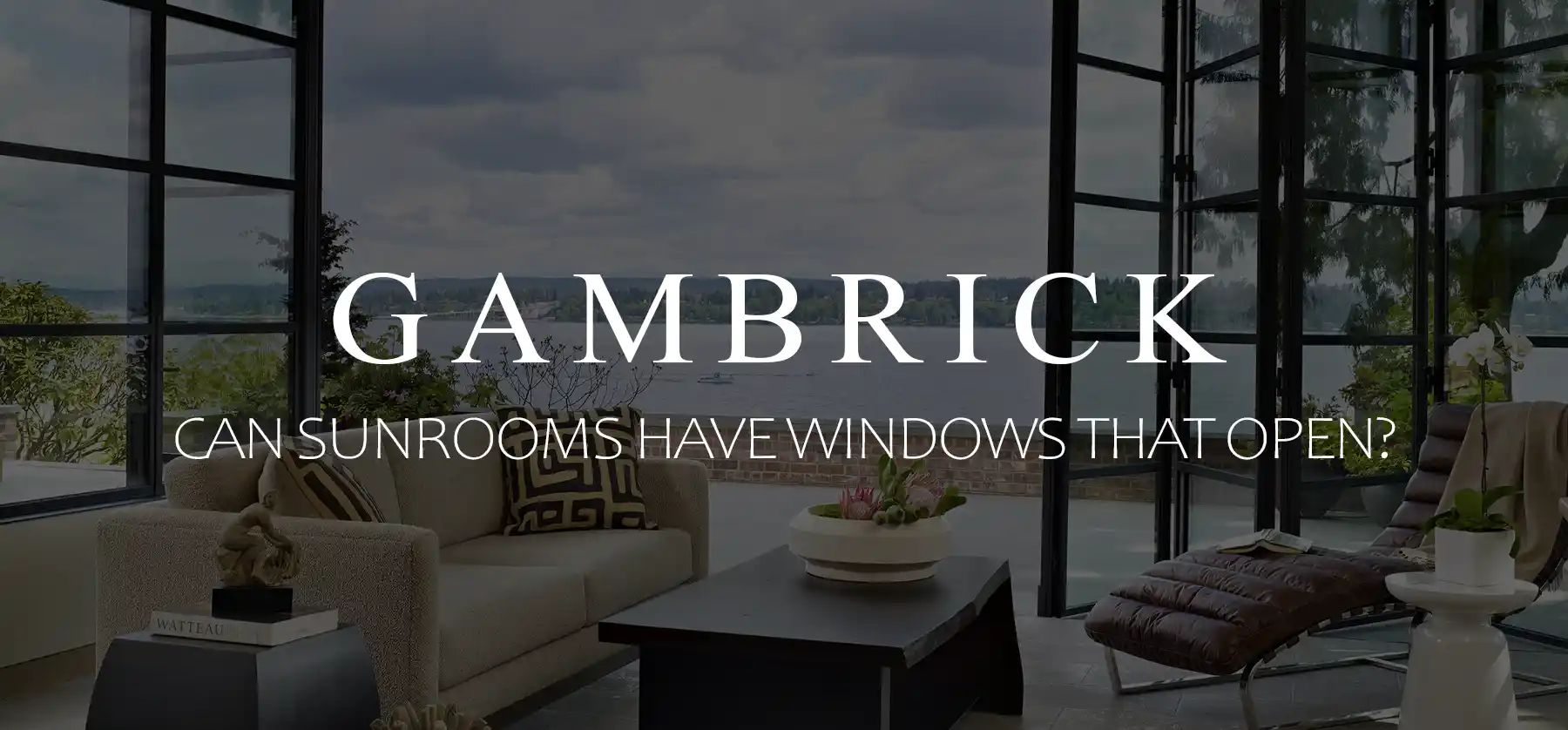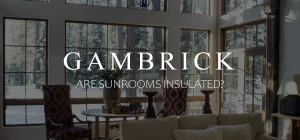
Can Sunrooms Have Windows That Open?

By John Mazzuca | About | More Posts |
John Mazzuca is a custom home builder with over 25 years experience in the construction industry. John has designed, managed, and built hundreds of homes & construction projects.
Sunrooms can have windows that open, which are called operable windows. Using operable windows in a sunroom design is quite common and offers several benefits. These windows can be opened to allow for ventilation, helping to regulate the temperature within the sunroom so they don’t get hot. They also let fresh air in and create the feeling of an open outdoor space while being protected from the elements when they’re closed.
Operable windows come in a few different styles, including sliding, casement, double-hung, or awning windows. Each design opens in a slightly different way.
- Sliding windows open by gliding side to side. Each window has two panes of glass that are split vertically down the middle.
- Double-hung windows open by sliding up and down. Each window has two panes of glass that are split horizontally.
- Casement windows is a popular window style that attaches to their frame by one or more hinges at the side. They open by swinging outwards (and sometimes inwards) to the left or right, much like a door when the small crank is turned.
- Awning windows is a type of window characterized by their hinge mechanism, which allows them to open outward from the bottom. They’re similar to casement windows because they have a crank. They’re excellent for ventilation because they can be opened slightly to create a gap Awning windows allow for air circulation while still protecting from the rain, as the glass pane acts as a shield.
I’ve been a NJ sunroom contractor for 25 years and can tell you firsthand how important it is to choose windows that provide a good seal when closed to maintain energy efficiency. But it’s also beneficial to use windows that maximize the sunroom’s view.
Types of Sunroom Windows
Sunrooms are primarily a room of glass built on a foundation, deck, or patio, that’s designed to maximize the view and let in lots of natural light. Because sunrooms have so many windows, it’s important to choose them carefully.
Windows come in a few different styles, casement, double-hung, sliding, picture, and awning. Each can work in a sunroom.
When choosing sunroom windows, consider how you’ll be using the room. Do you want the windows to open and close or are they just there for the view? Do you have enough room for windows to swing open or should they slide? Will some of the windows be hard to reach? There are lots of questions to consider when deciding on windows.
Below are some of the most common types of windows for sunrooms:
Casement Windows
Casement windows are the best for a sunroom if you have enough room for them to crank open. They’re large panes of glass that open by pivoting in or out when you turn a small crank. The windows are vertical, which creates a much better view than double-hung windows since there’s no horizontal break in the middle of the window.
Unlike sliding and double hung windows, a casement window can open fully, which allows in tons of fresh air. They’re also easy to operate because the crank is located at the bottom of the window frame.
Casements come in large sizes, so you can create a wall of glass that opens and closes at the turn of a crank. They also seal tight, which is very energy efficient, and lock, so you can use them in an integrated sunroom design.
Double-Hung & Sliding Sunroom Windows
Unlike casement windows, which swing open when you turn a crank, double-hung and sliding windows don’t require exterior space to operate.
- Double-hung windows can be raised from the bottom or lowered from the top with two sashes that move independently and overlap each other.
- Sliding windows glide open horizontally from one side to overlap the other.
Since both types of windows slide on a track, they’re popular in sunrooms that overlook a deck, walkway or porch. I
n addition to maximizing interior and exterior space, double-hung and sliding windows are easy to operate and allow fresh air to circulate through the room.
The problem with double hung windows is that they split in the middle, so there’s a frame blocking the view. Sliding windows have a break too, but it’s vertical which doesn’t affect the view as much.
Double-hung and sliding windows can’t open fully so you don’t get as much fresh air and open views as you do with a casement.
Awning Windows
Awning windows work like a casement window turned on it’s side. When you turn the crank, the window opens vertically from the bottom. The is great if you need a slim window on top of a casement, double hung or sliding window.
Awning windows are usually used as an accent window, not as a primary window. Place them up high to allow in some fresh air or on top of a casement, sliding, or double-hung window to expand the view.
The great thing about awning windows is that when opened, the window acts as an awning to block falling rain and snow.
Because awning windows are usually placed up high, they can be hard to crank. But they make special poles you can attach to the cranks to make it easier.
Picture Windows for Sunroom
Picture windows are large panes of glass that don’t open so they’re primarily used for the view. If you want a floor to ceiling glass wall, it’s usually done with a picture window.
Because picture windows don’t open or lock, the frames can be slimmer, accentuating the view even further. They can be used along side operable windows if you want some ventilation.
Most picture windows are manufactured in the same sizes as operable windows so they can be used together.
Picture windows are often placed out of reach above other operable windows in place of awning windows. They come in lots of sizes and bring in tons of natural light.
Picture windows also provide enhanced security and energy efficiency because they don’t open.
What Type of Window is Best for a Sunroom?
The best type of window for a sunroom is a casement due to its design and functionality, which align perfectly with the typical uses of a sunroom. They offer unobstructed views, thanks to their large glass panes, which is a primary reason for having a sunroom. The expansive glass not only allows for panoramic views of the outdoors but also maximizes the amount of natural light that can enter the space. This makes the sunroom bright and inviting.
Casement windows have larger panes of glass than double-hung and awning windows, which provide a better view. They can also open fully, which is something sliding windows can’t do.
Casement windows are equipped with a crank mechanism that makes them simple to open and close. This is helpful for sunrooms where windows might be difficult to reach. They also come with a built-in lock, making them safe if your sunroom is integrated into the home.
The crank allows for precise control over ventilation. You can let in a gentle breeze or create significant airflow by varying how much you crank the windows open.
From an energy efficiency standpoint, casement windows are excellent. When closed, the sash presses tightly against the frame, creating an airtight seal. This minimizes heat transfer, keeping the sunroom warm in the winter and cool in the summer.
The tight seal also helps to keep out drafts, dust, and noise, contributing to a more comfortable and clean indoor space.
Casement windows combine aesthetics, functionality, and efficiency, making them an ideal choice for sunrooms. They enhance the enjoyment of the space by offering expansive views, easy operation, excellent ventilation, energy efficiency, and added security, all of which are key components for a comfortable and functional sunroom.
Do Sunroom Windows Have Screens?
Sunroom windows can have screens if they’re operable. All sunroom windows that open, including sliding, awning, double hung, and casement have screens.
Window screens provide a few important functions for a sunroom:
- Insect Protection: Screens are essential for keeping out mosquitoes, flies, and other insects while the windows are open. This allows you to enjoy fresh air without the annoyance or health risks associated with pests.
- Debris Reduction: Screens can help reduce the amount of outdoor debris, such as leaves and twigs, that might otherwise blow into the sunroom.
- UV Protection: Some modern screens are designed to provide UV protection, reducing the amount of harmful ultraviolet radiation that enters the space. This can help to prevent sun damage to furniture and flooring.
- Additional Privacy: Screens can also offer an extra layer of privacy, as they can make it more difficult for people to see inside the sunroom from the outside.
The type of screen used can vary. Standard screens provide basic protection from insects, while finer mesh options can offer better visibility and improved airflow. There are also specialized screens that are pet-resistant, providing durability against scratching and tearing.
When choosing screens for a sunroom, consider the local climate and the intended use of the space. For example, in areas with lots of insects, a tighter mesh is better. But in regions with strong sun exposure, screens with UV protection work best.
Overall, I highly recommend installing screens in your sunroom windows to keep bugs out when the windows are open.
Can Sunrooms Have Windows & Doors?
Sunrooms can have both windows and doors. Windows are a defining feature of a sunroom, as they allow for ample natural light and views of the outdoors while providing shelter from the elements. The windows in a sunroom are typically large and may cover most of the wall space. They can be fixed, operable, or a combination of both, with styles including sliding, casement, double-hung, or awning windows to allow for ventilation.
Doors in a sunroom are just as important as windows because they provide access to the outside and can contribute to airflow and accessibility. When choosing a sunroom door, I recommend doors that have lots of glass and open like a window.
Common types of doors used in sunrooms include:
- Sliding Glass Doors: These are popular for sunrooms because they save space and offer large uninterrupted views. They can be left partially open for ventilation or fully open to integrate the sunroom with the outdoors.
- French Doors: These add a touch of elegance and traditional appeal. They are hinged at the sides and meet in the middle when closed. French doors can swing inward or outward and are often used to connect the sunroom to the rest of the home or an outdoor space like a deck or patio.
- Folding Doors: Also known as bi-fold or accordion doors, they can open up an entire wall of the sunroom, creating a seamless transition between the indoor and outdoor spaces.
The best windows and door combination will depend on the homeowner’s preferences, the architectural style of the home, the intended use of the sunroom, and the local climate.
Properly selected windows and doors can enhance the functionality, aesthetics, and energy efficiency of a sunroom, making it a comfortable space to enjoy throughout the year.
If you have any questions or comments email or leave a comment down below.

John Mazzuca | About | More Posts |
Custom Home Builder
John Mazzuca is a custom home designer and builder at Gambrick with over 25 years experience in the construction industry. John has designed, built and/or remodeled hundreds of homes, small buildings, and commercial projects. He writes about business, real estate, home building, and household electronics. His work has been featured in Fox Business, Better Homes & Garden, House Beautiful, and more.



















